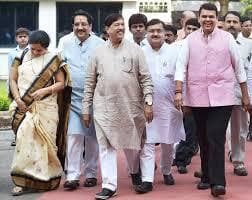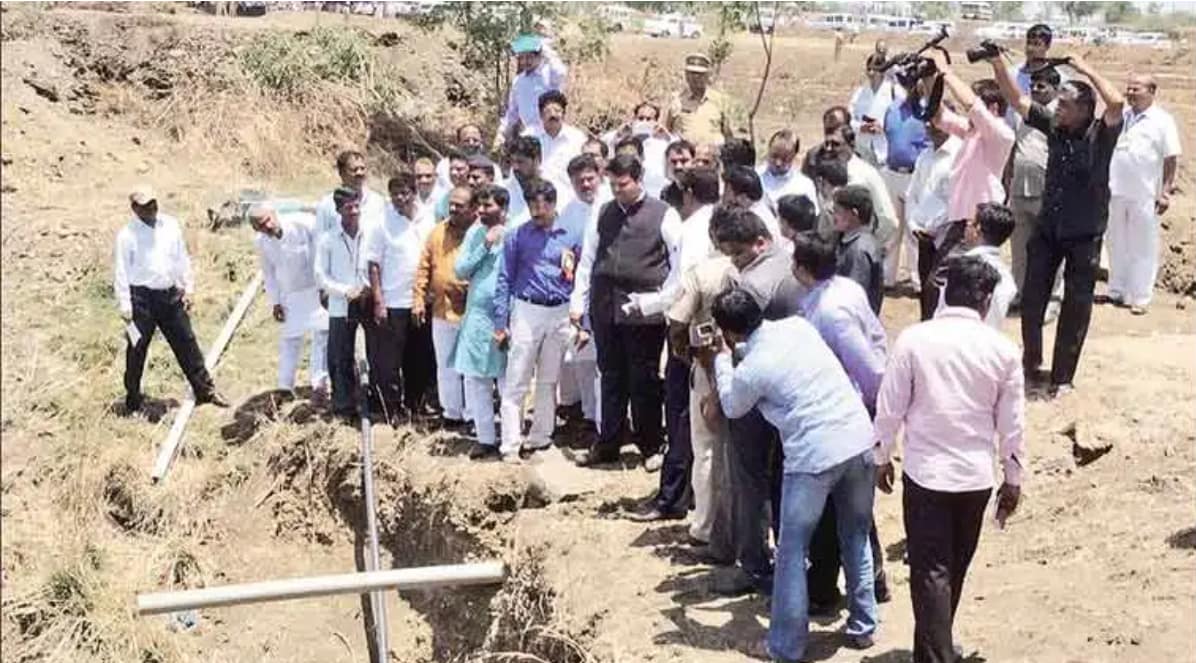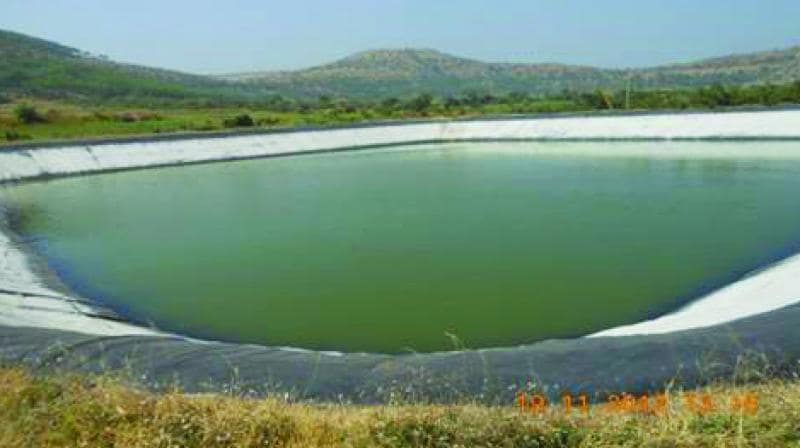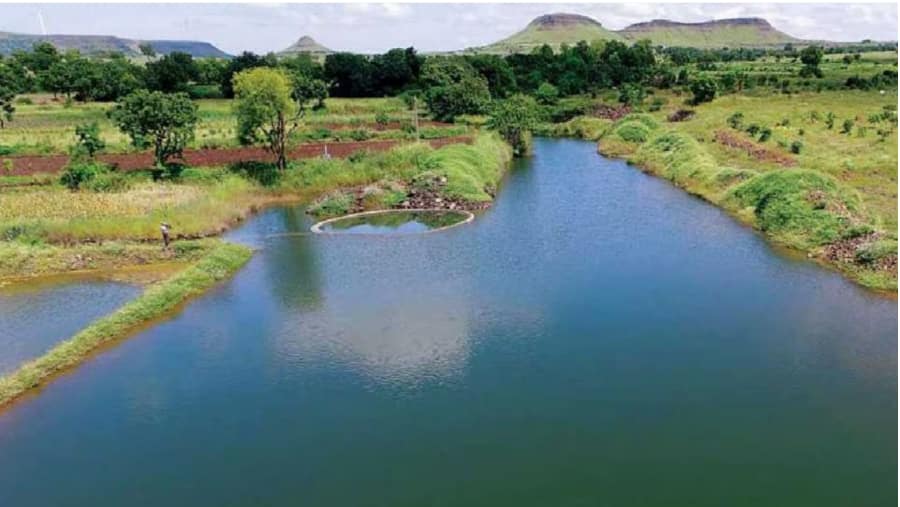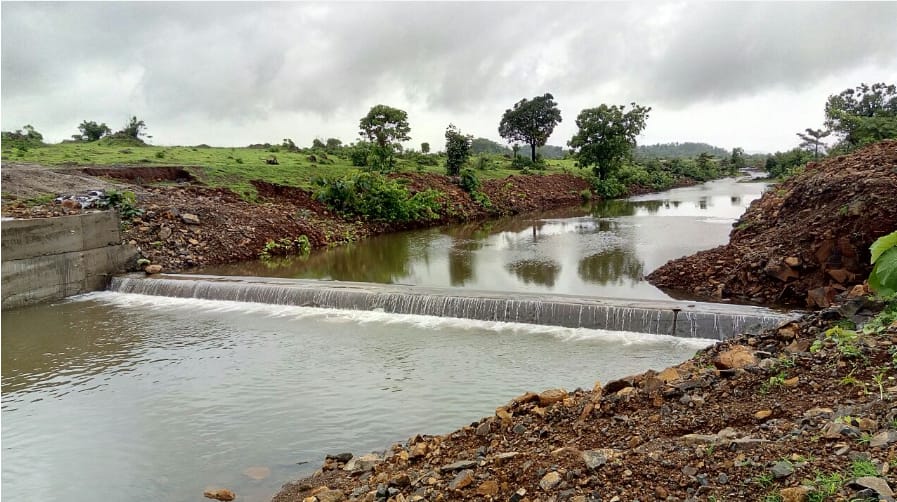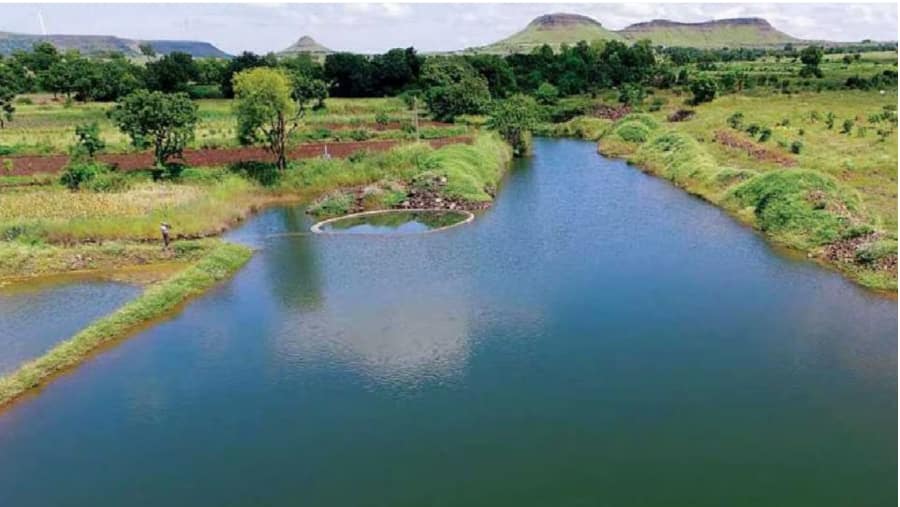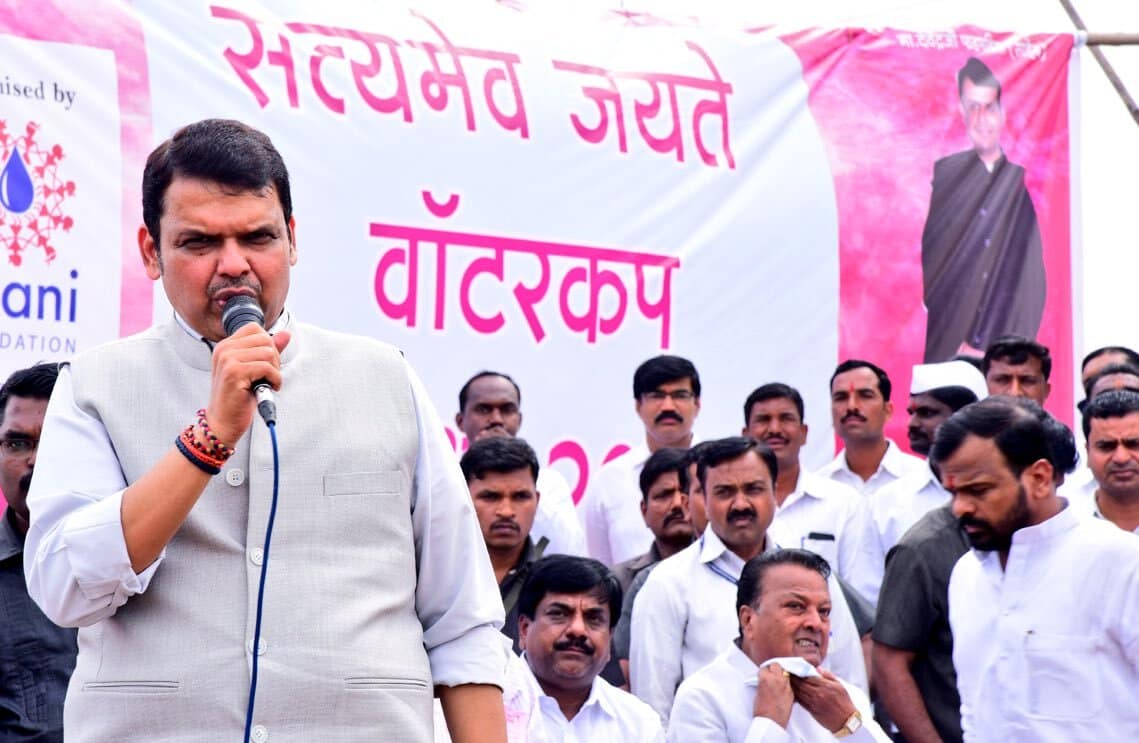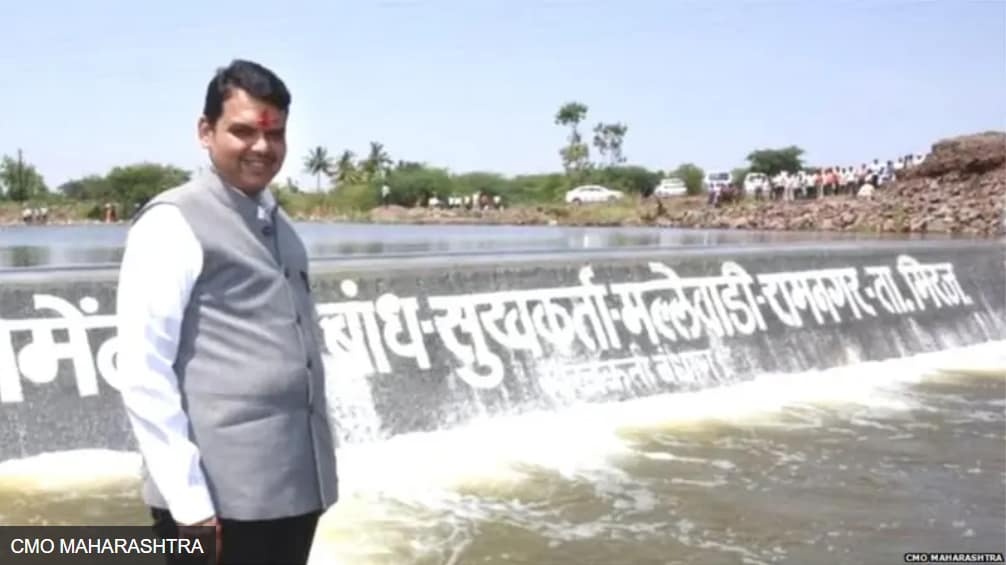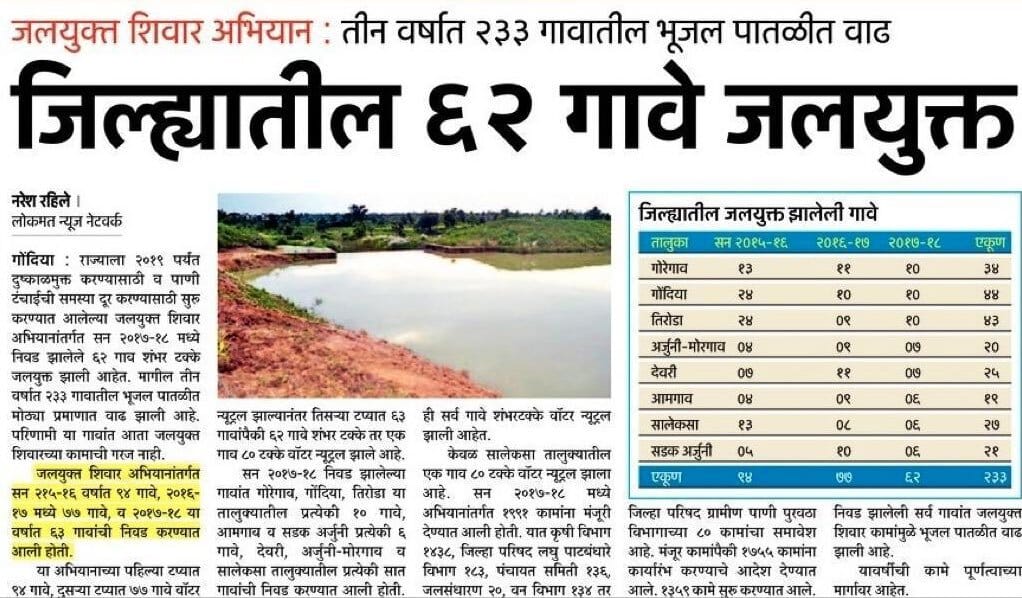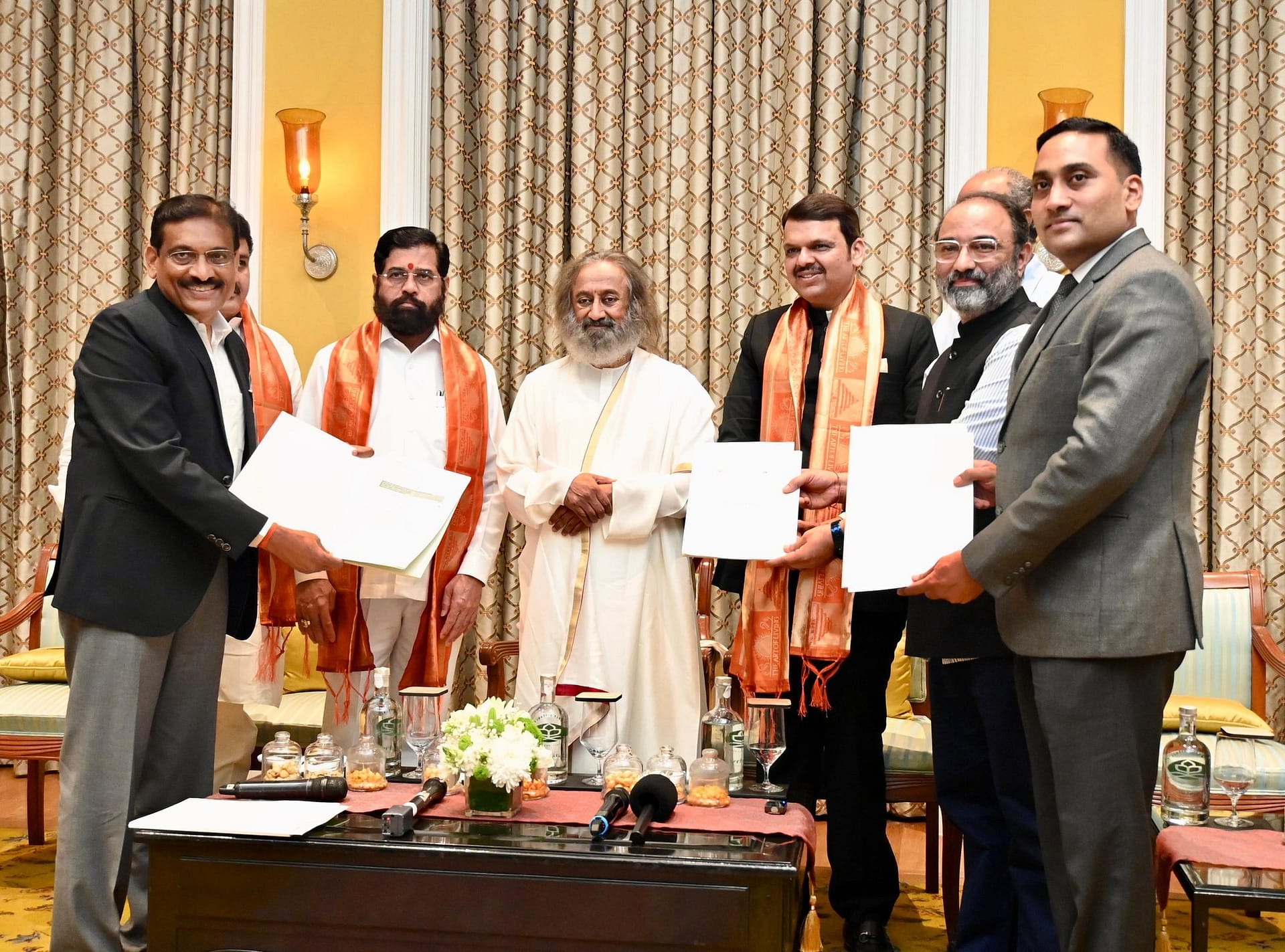Jalyukt Shivar Abhiyan (JSA), the flagship project of the Maharashtra government relaunched as JSA 2.0,…

The Jalyukt Shivar Abhiyan: A Sustainable Solution to Maharashtra’s Agri Problem
A large part of Maharashtra falls under a vast rain-shadow area, characterized by low to very low rainfall that leads to drought-like conditions every year, impacting the farmers and rural economy heavily. Jalyukt Shivar Abhiyan is an ambitious water conservation and water management project in Maharashtra, started in 2014 under the leadership of Chief Minister Devendra Fadnavis as a long-term solution to this perennial challenge of the state. The main objective of this scheme was to make the villages of the state water-sufficient with improved groundwater levels to sustain irrigation during the prolonged dry season. Declared a flagship project of the Fadnavis government, Jalyukt Shivar Abhiyan aimed at a tall target of making 5000 villages water-sufficient each year through an extensive watershed management program. The program included several measures, such as rejuvenation of reservoirs, deepening of nullahs, construction of new nullahs, recharging of water bodies, and more, by engaging the villagers, farmers, and NGOs. Up to 2019, the Jalyukt Shivar program was vigorously implemented across Maharashtra. After the formation of the Mahayuti government in the state in 2023, Devendra Fadnavis in his new role as the Dy. Chief Minister, launched the second phase of the Jalyukt Shivar scheme.
Cabinet sub-committee formed to review drought situation
Devendra Fadnavis took oath as the Chief Minister of Maharashtra on October 31, 2014. Within 15 days, the state was hit by a severe drought. Despite lacking prior experience, Devendra ji decided to get to the root of the drought cause and find sustainable solutions. Due to severe drought through the summers of 2013-14, the Kharif crop prices in the villages were reduced to less than 50 paise. The state cabinet, in its meeting held on 18 November 2014, decided to send a detailed report to the Central Government for immediate assistance to the affected farmers of the village. A Cabinet subcommittee headed by the Relief and Rehabilitation Minister was formed to review the crop and water situation in the state.
Jalyukt Shivar Abhiyan Related Photos & Video - 18 Nov 2014
Jalyukt Shivar Abhiyan Related Social Media Buzz - 18 Nov 2014
Jalyukt Shivar Abhiyan Related GR & Other Links - 18 Nov 2014
GR
Useful Links
A relief request for Rs 4,000 crore was sent to the Centre.
The drought-like situation in Marathwada and other parts of the state caused large-scale damage to crops and orchards. On November 27, 2014, the State Cabinet approved a proposal to seek Rs 4,000 crore from the Centre to provide relief to the affected farmers. It also decided to support the implementation of various measures by the state government for the villages reeling under water scarcity.
Jalyukt Shivar Abhiyan Related Photos & Video - 27 Nov 2014
Photo Gallery
Information Not Available
YouTube
Jalyukt Shivar Abhiyan Related Social Media Buzz - 27 Nov 2014
Jalyukt Shivar Abhiyan Related GR & Other Links - 27 Nov 2014
GR
Useful Links
Study of various patterns in the state for drought relief
Chief Minister Devendra Fadnavis reviewed the water conservation schemes successfully implemented in different parts of the state to find a permanent solution to the drought situation in the state. After studying about 28 schemes like the Ralegan Pattern, Shirpur Pattern, and Hivre Bazar Pattern, it was decided to implement them together.
Jalyukt Shivar Abhiyan Related Photos & Video - 30 Nov 2014
Jalyukt Shivar Abhiyan Related Social Media Buzz - 30 Nov 2014
Jalyukt Shivar Abhiyan Related GR & Other Links - 30 Nov 2014
GR
Useful Links
Launch of the Jalyukt Shivar program.
Considering the continuous water scarcity situation in the state, the Jalyukt Shivar scheme was launched on 5 December 2014 to increase the water level on the ground through proper planning and implementation and by engaging villagers to overcome the drought permanently. Jalyukt Shivar was given the status of flagship project of the government.
Jalyukt Shivar Abhiyan Related Photos & Video - 5 Dec 2014
Jalyukt Shivar Abhiyan Related Social Media Buzz - 5 Dec 2014
Jalyukt Shivar Abhiyan Related GR & Other Links - 5 Dec 2014
GR
Useful Links
Rs. 1000 crore allocated for the Jalyukt Shivar Yojana
In his first budget, Chief Minister Devendra Fadnavis allocated Rs 1,000 crore for the Jalyukt Shivar Abhiyan program to implement works such as preventing rainwater wastage after falling on the ground, increasing the groundwater level, creating water reserves, planning water for every village, etc. to make the villages drought-free. Additional allocations of Rs 7272 crore for irrigation, Rs 330 crore for micro-irrigation, and Rs 500 crore for constructing cement drains were also made.
Jalyukt Shivar Abhiyan Related Photos & Video - 18 Mar 2015
Photo Gallery
YouTube
Jalyukt Shivar Abhiyan Related Social Media Buzz - 18 Mar 2015
Jalyukt Shivar Abhiyan Related GR & Other Links - 18 Mar 2015
GR
Useful Links
The Jalyukt Shivar model would also be implemented in Rajasthan and Telangana.
Maharashtra’s Jalyukt Shivar Yojana model was said to be adopted in Rajasthan and Telangana. Delegations from these states shared with Jalyukt Shivar Abhiyan information and the implementation aspects by the state. The Rajasthan government decided to launch their program in January 2026.
Jalyukt Shivar Abhiyan Related Photos & Video - 1 Dec 2015
Jalyukt Shivar Abhiyan Related Social Media Buzz - 1 Dec 2015
Jalyukt Shivar Abhiyan Related GR & Other Links - 1 Dec 2015
GR
Useful Links
Magel Tyala Shettale yojana was announced
The Magel Tyala Shettale Yojana, or the farm pond on demand scheme, was announced by the government as an important part of the Jalyukt Shivar Abhiyan scheme to achieve a permanent solution for drought. The Magel Tyala Shettale scheme was found to be beneficial to the farmers as it helped with sustainable irrigation, making water available even during summer, Farm ponds also helped increase the water level of the farmland. Chief Minister Devendra Fadnavis announced the Magel Tyala Shettale yojana in the 2015 winter session in Nagpur. It was launched on February 17, 2016. The government declared the scheme a flagship program.
Jalyukt Shivar Abhiyan Related Photos & Video - 17 Feb 2016
Jalyukt Shivar Abhiyan Related Social Media Buzz - 17 Feb 2016
Jalyukt Shivar Abhiyan Related GR & Other Links - 17 Feb 2016
GR
Useful Links
Participation of Non-Governmental Organizations in the Jalyukt Shivar Scheme
It was decided to involve non-governmental organizations (NGOs) in the Jalyukt Shivar Scheme to carry out different works like desilting rivers, dams, drains, and rivulets, construction of farm ponds, and so on, in addition to government functioning and public participation on a large scale.
Jalyukt Shivar Abhiyan Related Photos & Video - 4 May 2016
Photo Gallery
YouTube
Jalyukt Shivar Abhiyan Related Social Media Buzz - 4 May 2016
Jalyukt Shivar Abhiyan Related GR & Other Links - 4 May 2016
GR
Useful Links
Remittance from the Chief Minister’s Relief Fund to help work under the Jalyukt Shivar Program
Chief Minister Devendra Fadnavis decided to provide Rs 10 crore for Aurangabad, Rs 5.94 crore for Latur, and Rs 2 crore each for the remaining 16 districts from the Chief Minister’s Relief Fund to expedite the works of the Jalyukt Shivar scheme in the villages suffering from acute shortage of water.
Jalyukt Shivar Abhiyan Related Photos & Video - 30 May 2016
Jalyukt Shivar Abhiyan Related Social Media Buzz - 30 May 2016
Jalyukt Shivar Abhiyan Related GR & Other Links - 30 May 2016
GR
Useful Links
Awards to journalists for outstanding coverage and for spreading awareness about water conservation activities under the Jalyukt Shivar Yojana.
The success of Jalyukt Shivar Abhiyan is related to vital tasks such as stopping soil erosion, storing water in the soil using various measures from the head to the bottom of the watershed, maintaining the texture of the soil, and increasing its productive capacity, etc. were undertaken in the villages of the state. The Fadnavis government decided to reward journalists who were engaged in spreading awareness about the progress of these activities of water conservation in the state through their articles and reporting. Also, with a view to increase people’s participation in the program, the government decided to honor the journalists who spread the Jalyukt Shivar Abhiyan purposes, work progresses, and positive news through their articles.
Jalyukt Shivar Abhiyan Related Photos & Video - 28 Sep 2016
Photo Gallery
YouTube
Jalyukt Shivar Abhiyan Related Social Media Buzz - 28 Sep 2016
Jalyukt Shivar Abhiyan Related GR & Other Links - 28 Sep 2016
GR
Useful Links
Public enthusiasm and participation behind the success of Jalyukt Shivar
Under the leadership of Chief Minister Devendra Fadnavis, 2 lakh 41 thousand 97 works were carried out in 11 thousand 483 villages since the launch of the Jalyukta Shivar Yojana, nearly 2 years ago. Most of these works were done through public participation, which saved the government nearly Rs. 500 crore. 42 TMC of water was obtained, and an irrigation capacity for 12 lakh hectares of land was created through these 2 years of the flagship project..
Jalyukt Shivar Abhiyan Related Photos & Video - 1 Oct 2016
Photo Gallery
YouTube
Jalyukt Shivar Abhiyan Related Social Media Buzz - 1 Oct 2016
Jalyukt Shivar Abhiyan Related GR & Other Links - 1 Oct 2016
GR
Useful Links
Jalyukt Shivar Abhiyan is becoming a model project in the country
The success of the Jalyukt Shivar Yojana resonated at the national level, making some states contemplate the adoption of this scheme. Rajasthan and Telangana already decided to implement the scheme to combat drought. Chief Minister Devendra Fadnavis decided to further implementing the scheme across the state, and it paid the dividend. It was seen that the groundwater level in many villages had increased through this scheme.
Jalyukt Shivar Abhiyan Related Photos & Video - 12 Jan 2017
Jalyukt Shivar Abhiyan Related Social Media Buzz - 12 Jan 2017
Jalyukt Shivar Abhiyan Related GR & Other Links - 12 Jan 2017
GR
Useful Links
Increase in groundwater level due to Jalyukt Shivar Yojana
The success of Jalyukt Shivar Yojana, which became a popular movement, brought the name of Maharashtra to the world level. The scheme, implemented through the voluntary participation of people, led to an increase in the water level in many areas, including Marathwada division. Marathwada, despite having scanty rainfall till then, had a good increase in the groundwater level, thanks to the Jalyukt Shivar Yojana.
Jalyukt Shivar Abhiyan Related Photos & Video - 12 Apr 2018
Jalyukt Shivar Abhiyan Related Social Media Buzz - 12 Apr 2018
Jalyukt Shivar Abhiyan Related GR & Other Links - 12 Apr 2018
GR
Useful Links
Decrease in the number of tankers
Within 3 years since it was launched the Jalyukt Shiver Yojana, undertaken by the Devendra Fadnavis government, turned 13,000 villages in the state drought-free. As a result, the number of water tankers in the drought-affected villages was also reduced. The earlier number of 6140 tankers daily came down to 152 in 2018. Rs. 7258 crores were spent for the Jalyukta Shiwar Yojana until this time. Of this, Rs 630 crore was collected through public participation.
After being sworn in as Chief Minister on 31st October 2014, Devendra ji immediately focused on drought relief and announced the Jalyukta Shivar Yojana in the state on 5th December 2014. The scheme, with abundant public support and participation, made numerous villages drought-free. Water tankers in many villages were stopped. In 2015, 6140 tankers were required to supply drinking water in the state. That number shrank to 1,379 in 2016, 366 in 2017, and 152 in 2018. Due to the Jalyukta Shivar Yojana, tanker water in nearly 6 thousand villages was stopped in 4 years.
Jalyukt Shivar Abhiyan Related Photos & Video - 11 Jun 2018
Photo Gallery
YouTube
Jalyukt Shivar Abhiyan Related Social Media Buzz - 11 Jun 2018
Jalyukt Shivar Abhiyan Related GR & Other Links - 11 Jun 2018
GR
Useful Links
Extension of Jalyukt Shivar Yojana till December 2019
Under the Jalyukt Shivar Yojana, a March 2019 deadline was set to convert several drought-affected villages in the state to drought-free. However, as the project works in those villages couldn’t be completed in 2018-19, the deadline was extended to December 2019.
Jalyukt Shivar Abhiyan Related Photos & Video - 1 Mar 2019
Photo Gallery
Information Not Available
YouTube
Jalyukt Shivar Abhiyan Related Social Media Buzz - 1 Mar 2019
Jalyukt Shivar Abhiyan Related GR & Other Links - 1 Mar 2019
GR
Useful Links
20 thousand villages to have 100% water independence through the Jalyukt Shivar Yojana
Through the Jalyukt Shivar Yojana, a target was set to make 25000 villages drought-free in 5 years, i.e., 5000 villages every year from 2015 to 2019. Accordingly, till 2019, 6 lakh 32 thousand 896 works were completed in 22 thousand 593 villages under the Jalyukta Shivar Yojana. Due to these works, 20 thousand 544 villages became 100% water sufficient. This created a total water storage of 27 lakh 8 thousand 297 TMC. and 39 lakh 4 thousand 394 hectare irrigation capacity.
Jalyukt Shivar Abhiyan Related Photos & Video - 12 Sep 2019
Photo Gallery
YouTube
Jalyukt Shivar Abhiyan Related Social Media Buzz - 12 Sep 2019
Jalyukt Shivar Abhiyan Related GR & Other Links - 12 Sep 2019
GR
Useful Links
Jalyukt Shivar scheme suspended by Mahavikas Aghadi
After the 2019 elections, Uddhav Thackeray formed the Maha Vikas Aghadi government in the state along with the Congress and the Nationalist Congress Party. The government led by Chief Minister Uddhav Thackeray delayed the scheme by ordering an inquiry into the works done in Jalyukt Shivar Yojana, the famous drought eradication program initiated by Devendra Fadnavis. On October 14, 2020, through a cabinet meeting, a politically biased decision was made
to hold an open inquiry into the works done under the Jalyukt Shivar Yojana and suspend this scheme. Under this decision, an inquiry committee was constituted on 1 December 2020, under the chairmanship of the retired Additional Chief Secretary. However, once again there was a change of power in the state with a new coalition government replacing the MVA government in 2022. This resulted in quashing the bogus allegations and inquiry into the Jalyukt Shivar scheme ordered by the previous MVA government comprised of Congress, the Nationalist Congress Party (Sharad Pawar group), and Shiv Sena (Uddhav Thackeray group),
Jalyukt Shivar Abhiyan Related Photos & Video - 14 Oct 2020
Jalyukt Shivar Abhiyan Related Social Media Buzz - 14 Oct 2020
Jalyukt Shivar Abhiyan Related GR & Other Links - 14 Oct 2020
GR
Useful Links
Initiation of Jalyukt Shivar 2.0 in the state by the Mahayuti Govt
In June 2022, the Maha Vikas Aghadi government was replaced by the Maha Yuti government with Devendra Fadnavis taking charge as the Deputy Chief Minister of the state. The Jalyukt Shivar scheme 2.0 was approved through a cabinet meeting held on 13 December 2022 under the chairmanship of the Chief Minister. It was also decided to cover 5 thousand villages under this scheme in the next 3 years. The government’s decision to start the Jalyukta Shivar scheme 2.0 was released on January 3, 2023.
Jalyukt Shivar Abhiyan Related Photos & Video - 13 Dec 2022
Photo Gallery
Information Not Available
YouTube
Jalyukt Shivar Abhiyan Related Social Media Buzz - 13 Dec 2022
Jalyukt Shivar Abhiyan Related GR & Other Links - 13 Dec 2022
GR
Useful Links
Agreement between Government and Art of Living regarding Jalyukta Shivar Yojana
After the grand coalition government in the state took charge, Deputy Chief Minister and Water Resources Minister Devendra Fadnavis launched the Jalyukt Shivar Yojana 2.0. A Memorandum of Understanding was signed between the State Government and the Art of Living Trust to implement the scheme under this new phase.
Jalyukt Shivar Abhiyan Related Photos & Video - 26 Nov 2023
Jalyukt Shivar Abhiyan Related Social Media Buzz - 26 Nov 2023
Jalyukt Shivar Abhiyan Related GR & Other Links - 26 Nov 2023
GR
Useful Links
Agreement with Tata Motors, Naam Foundation, and Bharatiya Jain Sanghatana under Jalyukta Shivar Yojana
In the presence of Chief Minister Devendra Fadnavis, a Memorandum of Understanding was signed between Tata Motors, Naam Foundation, and the Soil and Water Conservation Department of the Government of Maharashtra to increase the storage capacity of at least 1,000 reservoirs such as check dams, lakes, and rivers, by removing silt from their beds.
The first MoU – In the agreement signed between Tata Motors, Naam Foundation, and the Soil and Water Conservation Department of the Government of Maharashtra, it was decided to implement the government’s ‘Silt-Free Dams, Silt-Laden Shivar’ scheme to increase the storage capacity of the reservoirs in the state by removing silt from them, deepening them, and simultaneously increasing the groundwater level and increasing the income of the farmers in the area. Under this scheme, efforts will be made to restore at least 1,000 reservoirs including check dams, public lakes, and rivers in the state by removing silt from them. While Naam Foundation will be responsible for the actual work implementation in this. Tata Motors will manage the entire project and one Water Fellow will be appointed in each selected district through them.
Second MoU – Under the agreement signed between the Bharatiya Jain Sanghatana and the Soil and Water Conservation Department of the Government of Maharashtra, the former will create awareness and implement the collection of the removed silt under the ‘Silt-Free Dam – Silt-Laden Shivar’ scheme and distribute it on demands from the farmers involving the Gram Panchayats. For this, the Bharatiya Jain Sanghatana will appoint coordinators at the district levels.
Third MoU – In the last 20-25 years, numerous soil and water conservation projects have been executed in silos by various departments under various schemes in the state, creating a large number of water bodies. An agreement has been signed between the Maharashtra Remote Sensing Application Centre in Nagpur (MRSAC) and the Soil and Water Conservation Department of the state for mapping and verifying all these water bodies along with the natural ones. MRSAC will create cadastral databases and maps using satellite remote sensing and GIS technology. A web portal and mobile app will also be created for this. This agreement has been made for 5 years and a record of future new works, maintenance, and repair works will be maintained.
Jalyukt Shivar Abhiyan Related Photos & Video - 3 Feb 2025
Photo Gallery
Information Not Available
YouTube
Jalyukt Shivar Abhiyan Related Social Media Buzz - 3 Feb 2025
Jalyukt Shivar Abhiyan Related GR & Other Links - 3 Feb 2025
GR
Useful Links
Maharashtra is prepared to overcome drought
The Jalyukt Shivar scheme has become more of a people’s movement than a government-run program and has garnered people’s awareness, enthusiasm, and attention on water conservation methods in the villages. The initiative taken by the villagers of Diggalwadi in Nagpur district is inspiring other villages in Maharashtra. Similar to this village, news has been pouring in about water prosperity in many other villages, reinvigorating villagers and farmers in the drought-prone areas. This people’s movement, which was seeded by one resolute Chief Minister with a dream to eliminate drought from Maharashtra and make a greener future for the next generations, has now become a banyan tree. Maharashtra should celebrate the results yielded by people’s conviction in the project and determination to make it a success.
Jalyukt Shivar Abhiyan Related Photos & Video - 28 Apr 2025
Photo Gallery
Information Not Available
YouTube
Jalyukt Shivar Abhiyan Related Social Media Buzz - 28 Apr 2025
Jalyukt Shivar Abhiyan Related GR & Other Links - 28 Apr 2025
GR
Useful Links
A difficult goal made achievable.
The 1st phase of the Jalyukt Shivar Yojana created great enthusiasm among the villagers to participate in this extraordinary government-people initiative. The project made a phenomenal achievement of turning 20,544 villages water-sufficient. A total of 6,32,896 works were completed in 22,593 villages under the Jalyukt Shivar Yojana from 2015 to 2019. Water reservoirs of 27 lakh TCM were created to produce 39 lakh hectares of irrigation capacity in the state. Agriculture in the state has started surviving under less rainfall and during the long gap between the successive rainy seasons. Crop production (especially soya and cotton) has increased, and the dependency on water tankers in drought-prone areas has reduced to a large extent. Being an answer to the agri-challenges in rainshadow areas, the project was keenly followed within and outside the country. The governments of Rajasthan and Telangana took steps to replicate the project in their states. After a gap of 3 years, the 2nd phase of the project, Jalyukt Shivar Yojana 2.0, was started on 3 January 2023 to regain the momentum that was lost due to the scrapping of the project by the MVA government.

